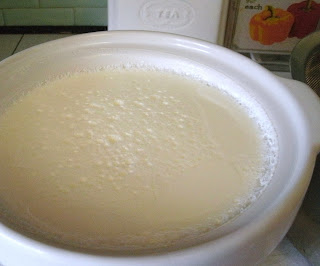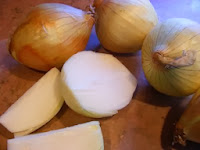I used to buy individual 6-oz containers of organic Greek yogurt ONLY when they went on sale for 99 cents each. Regularly priced, they were $1.99! I couldn't justify spending $10 a week on five small containers of yogurt to add to my brown bag lunches. Worst of all? I really didn't like the very sour flavor of the only plain organic brand available. I liked the creamy taste of Fage and Chobani brands, but eating organic dairy is important to me, so I opted to make my own and was surprised at how perfectly delicious it was. Now I make 4-6 servings of thick, creamy, ORGANIC, low-carb yogurt each week for less than $4. I'll never buy yogurt again, and neither should you!
Easy Steps (followed by more detailed instructions and photos):
1. Heat milk to 183 degrees
2. Pour into crock pot and cool to 115-119 degrees
3. Add yogurt starter
4. Place crock pot in cool oven with light on for at least 9, but up to 16 hours
5. Refrigerate homemade yogurt
6. Eat yogurt or continue on to one more step to make it Greek-style (thick, creamy, low-carb)
You'll Need:
-1/2 Gallon Organic Milk (I prefer 2%, but have used 1%)
-2 Tablespoons organic yogurt (sweetened is okay, as it is the cultures that you want). The first time you make yogurt, you'll need to use some purchased brand , but once you've made your own, you just keep two tablespoons aside for your next batch.
-Crock pot (I've used large, but now prefer small for ease of storing in the refrigerator)
-Medium Saucepan
-Cooking thermometer (battery-operated is a great investment and time saver, but optional)
- Large wooden spoon or Robo-stir* or other automatic stirring equipment (optional, but well-worth purchasing):
*Robo-stir continuously stirs your milk, so it will not burn or stick. Otherwise, you will need to hand stir continuously until milk is heated to correct temperature (183 degrees).
Note: Robo-stir has not been successful for other recipes or thicker soups/stews, but is perfect for this task and well worth the $8 investment. It takes four (4) AA batteries. I use rechargables and sometimes have to borrow them from the TV remote or digital camera on yogurt day!
 e e | |
| Robostir right out of the pan! |
For Greek-Style:
Strainer (fine mesh works best)
Coffee Filter (basket-style)
Detailed Instructions/Photos:
1. Pour approximately 3/4 of the carton of milk into saucepan over medium heat (electric stove: 5)
2. Switch on Robo-stir and place in pan (or hand stir continuously to prevent scorching milk)
3. Using auto-temp alert on thermometer, set to 183 degrees and submerge probe into milk or monitor manual thermometer
 |
| Magnetic timer stuck to stove with probe in pan |
4. Pour approximately 1/4 cup milk into separate bowl, mix in 2 Tablespoons of yogurt starter, and set aside
5. When heated milk reaches 183 degrees, remove from heat. I usually let the Robo-stir continue for a few minutes.
6. Pour heated milk into crock pot, move to a cooler spot in the kitchen, and put thermometer probe in place to wait for milk to cool to between 119 and 113 degrees. (I set my kitchen timer in 20 minute increments to make sure I remember to check the dropping temperature before it goes too low.)
 |
| Pour hot milk into small crock pot - tuna can for size reference |
 |
| Add starter when temperature drops to 112 - 115 degrees |
7. When milk reaches approximately 115 degrees, stir in mixture of milk/yogurt starter that you had set aside earlier.
8. Place ceramic crock pot liner into base, add cover, and place in unheated oven.
9. Turn on the oven light, which should provide just enough heat to let the yogurt set up overnight.
10. Place a clean kitchen towel over the top of the crockpot cover to incubate further, and leave undisturbed for at least 9 hours, but up to 16.
11. Nine (9) to 16 hours later, place the crock pot liner (now full of homemade yogurt) in the refrigerator.
 |
| The yogurt is perfectly set |
Greek-style:
1. Place fine mesh strainer over a saucepan of similar size.
2. Line with a basket-style coffee filter
3. Fill up filter with yogurt
4. Cover with plate (my choice) or plastic wrap and return to refrigerator
5. In a few hours, the whey will have drained into the pan, and creamy Greek-style yogurt remains to eat (usually, it will just fall away from the filter lining if you are transferring to a large bowl. If you are only in need of one serving, you can take a few spoonfuls at a time.
Note: Because of my refrigerator size, I am limited to the size of my crock pot and saucepan system. If you have more space, you could try more than a half gallon at a time, but this weekly process works for me and provides 4-6 servings of delicious, Greek-style yogurt for only $3.69 per week!









